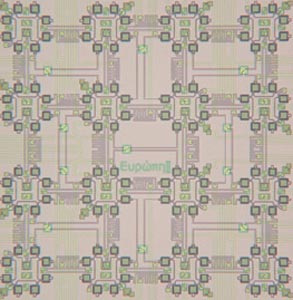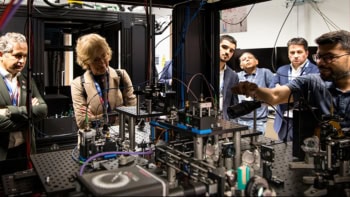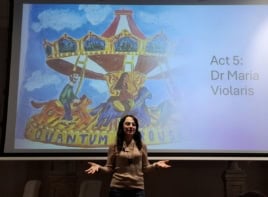A small Canadian company says it has built the world’s first commercial quantum computer. But, as Edwin Cartlidge reveals, not everyone is convinced that the firm’s claims stack up

The 300 or so scientists, journalists and entrepreneurs who gathered at the Computer History Museum in California’s Silicon Valley on 13 February had, on the face of it, come to see a man solve a Sudoku puzzle on a laptop. Why did they bother turning up, you might ask. The reason was that the puzzle was apparently not being solved by the laptop, but by another computer, connected over the Internet, that was sitting in a lab in Vancouver. This second computer was no ordinary digital device but, according to the company D-Wave carrying out the demonstration, the “world’s first commercially viable quantum computer”.
If D-Wave, which was spun out from the University of British Columbia in 1999, has indeed built such a device, it would have made a huge breakthrough. For about the last 20 years some of the brightest minds in academia and industry have been attempting to build a quantum computer – a machine that can, in principle, exploit the weird laws of quantum mechanics to vastly outperform classical computers when carrying out certain types of calculation. But although these scientists have constructed primitive prototypes, they are still probably at least a decade away from building a useful quantum computer, such is the difficulty of manipulating delicate quantum systems without destroying them in the process.
It was perhaps no surprise then that the media reacted enthusiastically to D-Wave’s demonstration, proclaiming that “Canadians win race to build ‘super computer'”, to quote one headline. But is the breakthrough really all it is cracked up to be? Given the slightly mysterious nature of the demonstration and a lack of accompanying technical information, many other scientists in the field remain highly sceptical. Phil Keukes, a quantum-computing researcher at Hewlett Packard in Palo Alto, California, is one of these. “D-Wave seems to be using certain quantum effects in its machine,” he says. “But it is not clear that it has a quantum computer.”
Inside Orion
Quantum computers exploit the ability of quantum systems to exist in two states at the same time. Rather than use bits, which are either 1 or 0, they use qubits, which can be in a superposition of both 1 and 0 simultaneously. The idea is that if a quantum computer has N such qubits, these can then be combined or “entangled” to represent 2N values at the same time. By processing each of these values simultaneously, a quantum computer could, in principle, operate exponentially faster than its classical counterpart.
Researchers have built very basic quantum computers – consisting of at most a handful of qubits – using the quantum states of a variety of microscopic systems, including ions confined by electromagnetic fields, neutral atoms, photons and the minuscule pieces of semiconductor known as quantum dots. D-Wave, however, has built the 16 qubits in its machine – known as Orion – from loops of superconducting niobium. The advantage of using superconducting materials is that – unlike atoms and photons – they are macroscopic objects that can be fabricated and manipulated using conventional microchip technology. The pairs of electrons inside a superconductor, which lead to it having a zero resistance below a certain temperature, all exist in the same quantum state and therefore confer quantum properties to the superconductor as a whole.
Each of Orion’s qubits is about 50 µm across and the chip on which they are mounted measures 5 mm by 5 mm (in contrast, the whole system, including refrigeration equipment, has a volume of about 45 m3). Current within Orion’s qubits can circulate either clockwise or anticlockwise around the loop, or in a mixture of both directions, corresponding to a 0, 1 or a superposition of the two values. The value of each qubit at any one time is determined by three controllable parameters – an individual qubit’s own “bias” towards 1 or 0; the coupling between neighbouring qubits (i.e. whether their currents want to align or circulate in opposite directions); and the energy barrier between different qubit states (which can be overcome by quantum tunnelling).
To perform a calculation, Orion is first cooled down to just 0.01 K to minimize the thermal noise than can wreck quantum states. With qubits initially set to the same value, the three parameters are adjusted via instructions contained within an algorithm that is fed to the computer. Once all the adjustments have been made and the system settles into a stable state, the answer to the calculation is then a 16-bit digital number given by the final values of the qubits.
Orion is designed to solve a class of problems known as “NP-hard”, which essentially involves finding the minimum or maximum of a certain function (matching biological molecules with one another, for example, means maximizing the similarity of structure). Such problems are “intractable” because the time that a classical computer would need to solve them increases exponentially with the size of the dataset involved. The beauty of Orion is that, in principle, it does not find the answer through brute number crunching but by allowing the rules of quantum mechanics to determine the most stable values of individual qubits given the competing forces of bias and coupling. “We are essentially tapping into the equation-solving potential of nature,” says physicist Geordie Rose, a founder and chief technology officer of D-Wave.
Only so fast
According to D-Wave, Orion takes about 100 times longer to solve a given problem than the best known classical algorithm attacking the same problem on one of the firm’s PCs. But Rose says that as the company increases the number of qubits on the chip – it claims it will have a staggering 1024 qubits by the end of next year – Orion will become competitive with the best classical algorithms available. These upgrades will follow a 32-qubit version of Orion, access to which will be made available later this year via the Web.
So what is the catch – how has this small company managed to do something that has seemingly eluded all other research groups so far? The answer is that Orion is in fact not a fully-fledged quantum computer. It is instead what is known as an “adiabatic quantum computer”, which remains in the lowest possible energy level at all points in a calculation and is consequently less susceptible to decoherence – the destruction of the relative phase of different energy levels within a general-purpose quantum computer that occurs if the computer is exposed to the outside world. “For this reason, it is technically less challenging to scale to 16 qubits than with general-purpose superconducting qubits,” says Frank Wilhelm, a physicist who works on superconducting qubits at the University of Waterloo in Canada.
Rose acknowledges Orion’s limitations, pointing out, for example, that it cannot simulate other quantum-mechanical systems – which is likely to be one of the main applications of the first generation of general-purpose quantum computers and which would be of use to chemists and biologists, for example. He also points out that any quantum computer given an NPhard problem to solve is unlikely to be exponentially quicker than a classical machine and is instead likely to only be quadratically faster (although this could still potentially speed up calculations by factors of thousands). “We think a quadratic approach is more robust against noise,” he says. “This was a design choice, but one we believe provides huge market potential.”
Not everyone believes that Orion can achieve even a quadratic speed increase, however. Umesh Vazirani, a computer scientist at the University of California, Berkeley, says that for this to be achieved, Orion must vary the rate at which it executes its algorithm during the course of the calculation. But he thinks that no-one knows how to do this for the kind of calculations that D-Wave is attempting.
Rose admits that “there are unresolved issues related to finding good algorithms for the machines we’re building” but claims that the only way of ironing out these issues is through an “empirical approach”, essentially by continuously redesigning and rebuilding the processor rather than carefully building a device from first principles. While reluctant to provide details, Rose claims “it is beyond doubt” that Orion does exploit quantum-mechanical phenomena in its calculations. But he admits that he does not know whether a larger version of Orion will be able to harness the power of the quantum world. “The blunt truth is that no-one really knows how a large-scale machine will actually perform,” he adds.
Notwithstanding the uncertainty that surrounds its technology, D-Wave has so far managed to raise $38m – with about half the money coming from private venture capitalists and the other half from the Canadian government – and hopes to raise additional funds from established technology companies. And although Wilhelm remains sceptical about the potential of the adiabatic approach and would like D-Wave to publish a detailed, peer-reviewed account of Orion’s operation, he agrees with Rose on one thing – that the only true way to find out the potential of this technology is to build and test a larger version of the device. “Until this is done,” says Wilhelm, “the assessment of the power of this chip remains in limbo.”




